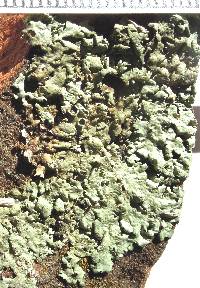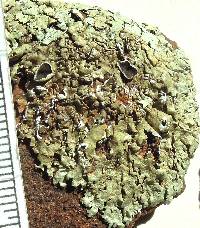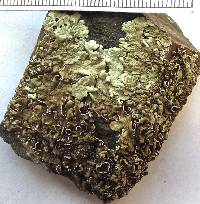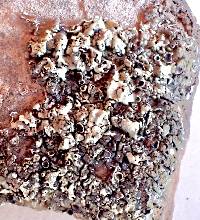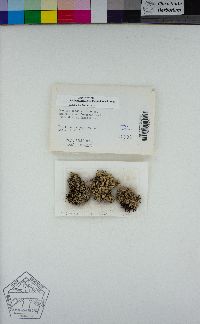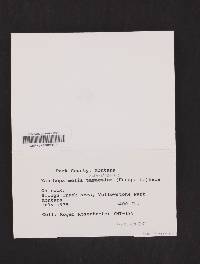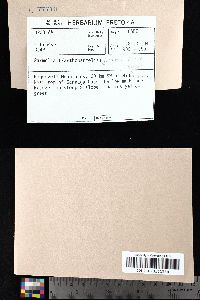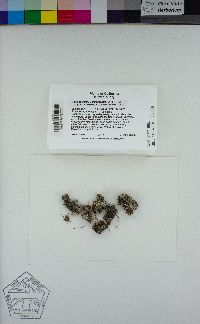
- Home
- Search
- Images
- Species Checklists
- US States: O-Z >
- US National Parks
- Central America
- South America
- US National Parks
- Southern Subpolar Region
|
|
|
|
Family: Parmeliaceae
[Parmelia conspersa var. coloradoensis Gyeln., moreParmelia imitans var. coloradoënsis (Gyeln.) Gyeln., Parmelia ioanis-simae Gyeln., Parmelia ioannis-simae var. coloradoënsis Gyeln., Parmelia phaeophana f. coloradoënsis (Gyeln.) Gyeln., Parmelia somloënsis var. rotundata Gyeln., Xanthoparmelia ioanis-simae (Gyeln.) Hale] |
Global occurrence: Americas – North America (incl Mexico) | Oceania – Pacific Islands (Melanesia, Micronesia, Polynesia) | Arctic. Substrate: rock – siliceous, siliciferous, acidic | rock, stones, pebbles – unspecified. Life habit: lichenized (mutualistic with algal photobionts). Thallus: foliose (foliaceous), leaf-like; [th] upper surface: yellow(ish) green | green(ish) yellow; [th upper surface]: epruinose; [th marginal and upper surface] specific structures: absent; [th] morphol substructures (eg areoles, lobes, branches) width [mm]: (low) 1.5 (high) 3.0; [th] morphol substructures (eg areoles, squamules): distantly discontiguous; [th] morphol substructures (eg areoles, lobes, branches) upper surface: smooth, plane | maculate; [th] lower surface: brown(ish) (if pale: fawn, tan; if mid: cinnamon); [th lower surface] specific structures: present; [th lower surface] rhizines, rhizoid structures: present; [th lower surface] rhizines, rhizinoid structures: unbranched, simple. Ascomata: absent | present; ascoma: apothecial, apothecioid – hymenial; ascoma [mm]: (low) 3.0 (high) 15.0; ascoma: subpedicellate, substipitate, subpedunculate, substalked; [ascm, if apoth] disc, mazaedium: plane, flat, flattened, expanded; [ascm, if apoth] disc, mazaedium: brown(ish) (if pale: fawn, tan; if mid: cinnamon); [ascm, if apoth] disc, mazaedium: epruinose; [ascm, if apoth] margin surface; [if perith] periostiolar area, ostiole, involucrellum: yellow(ish) green | green(ish) yellow; [ascm, if apoth] margin excipular photobionts: present | abundant; [ascm, if apoth] subhymenial layers, hypothecium; [if perith] basal excipulum: hyaline, colourless; [ascm] paraphyses/-oids: present; [ascm] epihymenium, epithecium: brown(ish) (if pale: fawn, tan; if mid: cinnamon). Asci: lecanoralean; [asc] tholus: thickened; [asc] tholus amyloidity (iodine reaction): present; [asc] tholus amyloidity pattern: amyloid with widening axial body towards the apex (= Lecanora-, Parmelia-, Rinodina-types etc). Ascospores: (median) 8.0; [asp] shape: ellipsoidal; [asp] length [µm]: (low) 7.0 (high) 9.0; [asp] width [µm]: (low) 4.0 (high) 5.0; [asp] septa: absent – spore lumen unilocular, monolocular; [asp] pigmentation: hyaline, colourless; [asp] perispore, epispore: not apparent. Conidiomata: absent | present. Conidia: bifusiform; [co] length [µm]: (low) 4.0 (high) 6.0. Secondary metabolites: present, consalazinic acid | norstictic acid | protocetraric acid | salazinic acid | usnic acid. Primary photobiont: present, chlorophytaceous – trebouxiaceous, chlorococcoid. Secondary photobionts (eg in cephalodia): absent. |
|
|
|



